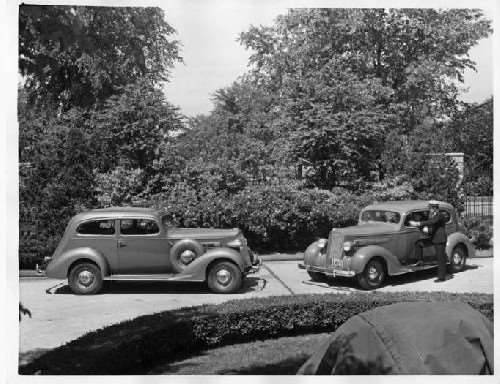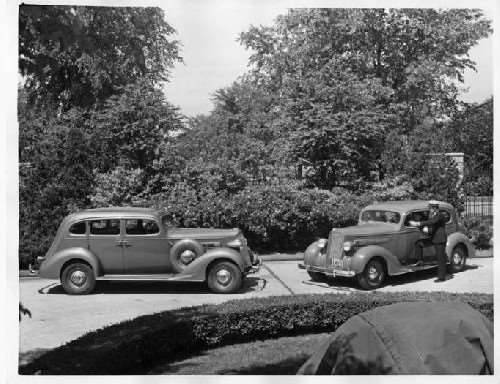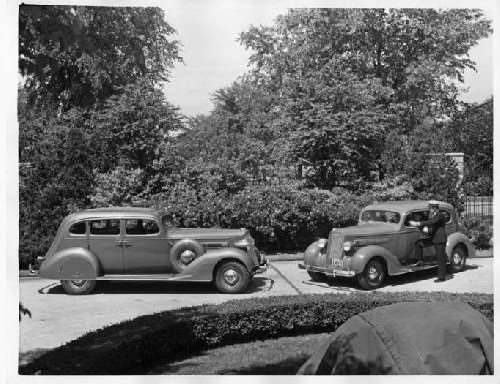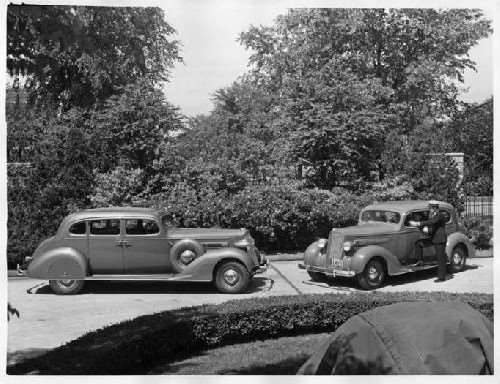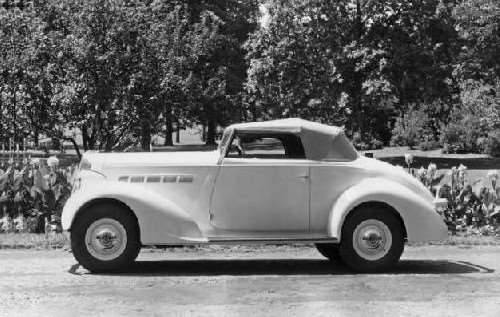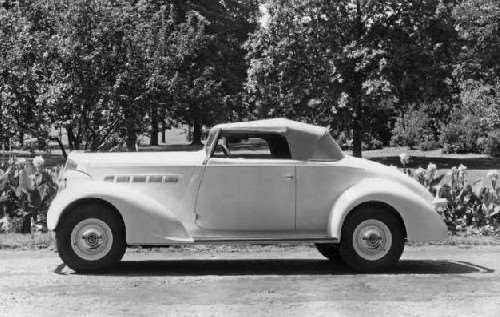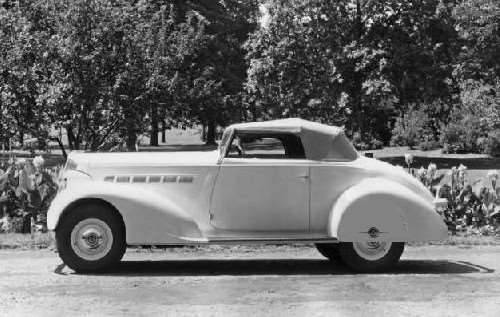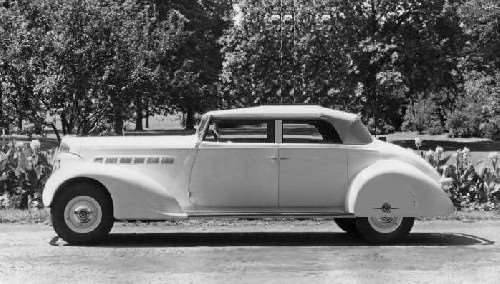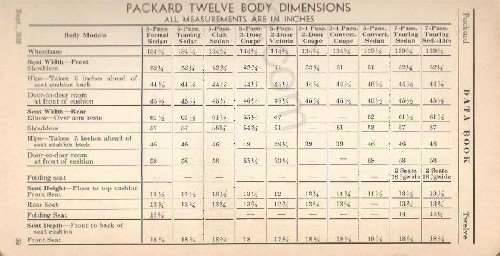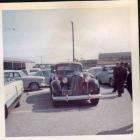|
Re: 1935 - Turning Point and What-Ifs
|
||||
|---|---|---|---|---|
|
Home away from home

|
Hi Paul
Thought-provoking! Time to dig into these concepts! Steve
Posted on: 2015/8/30 13:43
|
|||
|
.....epigram time.....
Proud 1953 Clipper Deluxe owner. Thinking about my next Packard, want a Clipper Deluxe Eight, manual shift with overdrive. |
||||
|
||||
|
Re: 1935 - Turning Point and What-Ifs
|
||||
|---|---|---|---|---|
|
Home away from home

|
Have at it, Steve!
One issue that jumps out immediately is whether the One Twenty body was big enough to serve as a senior Packard. The data sheets show a 53" width for shoulders in the '36 One Twenty with no break-out of front and rear, so assume front and rear are same. For the '39 Twelve the numbers are 52-1/4" in front and 57" in rear for the 134" wb touring sedan. If the One Twenty's 53" does in fact apply to rear and not just the front, such a width might not have been competitive with Cadillac, certainly would not have met Packard's own standard for a senior. I sat in a CD-138 a few years ago, seemed roomy enough. Never sat in a '35-39 Senior or Cadillac.
Posted on: 2015/8/30 16:50
|
|||
|
||||
|
Re: 1935 - Turning Point and What-Ifs
|
||||
|---|---|---|---|---|
|
Home away from home

|
Making both a junior and a senior line on the same platform makes a lot of sense. Some have put part of the blame for AMC's failure on platform proliferation which strained the company's finances by having to keep, with the advent of the Pacer, three platforms up to date at the same time.
It would have probably been better if Packard could have had a secondary brand for the cheaper line, like Lincoln had Zephyr, Chrysler had DeSoto and Cadillac had LaSalle, to get into a higher volume price class, without devaluing the Packard brand. Packard could have bought the rights to Auburn for a song in 37, but 37 was probably too late. Stutz failed in 35. They would have had to move on a mid market brand in the early 30s....about the time Studebaker went bankrupt in 33, but Studebaker would bring baggage that liquidated companies like Auburn and Stutz would not bring. Of the alternatives, I like Auburn because it was known for stylish, moderately priced cars powered by flathead sixes and straight eights. The timeline is just not optimal.
Posted on: 2015/8/30 18:05
|
|||
|
||||
|
Re: 1935 - Turning Point and What-Ifs
|
||||
|---|---|---|---|---|
|
Home away from home

|
Timeframe not optimal but still might have been workable, Auburn somewhat weakened by 1933 (who wasn't) when One Twenty planning began. I like the idea, has lots of merit. And the Packards that came off the One Twenty would have been priced near former Eight yet with great technology and styling and a large price bandwidth that would include truly stunning special models by the top coachbuilders.
The city of Auburn would not have been happy but such were the times.
Posted on: 2015/8/30 19:38
|
|||
|
||||
|
Re: 1935 - Turning Point and What-Ifs
|
||||
|---|---|---|---|---|
|
Home away from home

|
The city of Auburn would not have been happy but such were the times.
The company was toast anyway. By some accounts, it had been running on autopilot as Cord's interest had shifted to aviation, then he took it on the lam from stock manipulation charges. Packard could have afforded it. When Auburn was liquidated in 38, the parts inventory and the rights to the name were sold for $85,000. The HQ building sold for $25,000. Auburn somewhat weakened by 1933 (who wasn't) when One Twenty planning began. Packard may have been able to buy the rights to the name earlier, while the company was still a going concern, but it would have cost a lot more. From reports I read, Auburn sales held up fairly well when the depression first started. Sales crashed in 34 and Gordon Buehrig did a refresh of Alan Leamy's 1931 design, then did the Cord 810, so they were not ready to wave the white flag. Earliest possible time to buy the Auburn name on the cheap would have been when Auburn production ended in 36, which would be in the nick of time to put the name on the 115.
Posted on: 2015/8/30 20:43
|
|||
|
||||
|
Re: 1935 - Turning Point and What-Ifs
|
||||
|---|---|---|---|---|
|
Home away from home

|
On reflection, regarding having a different brand for the junior line, I wonder how many people bought a 120, and paid Packard's price, because it had a Packard badge on it. Call it an Auburn or Studebaker, and the price people would be willing to pay might be significantly lower, which would defeat Packard's objective of fattening profits.
Lengthening the 120 to produce a new senior series might have caused problems with interior room, as you suggest. So go the other way, design the senior cars first, then cut them down lengthwise for the junior series, nip some out of the rear seat, nip some out of the hood, chop the top a bit. Then do the same with the Clipper in 41.
Posted on: 2015/8/31 8:52
|
|||
|
||||
|
Re: 1935 - Turning Point and What-Ifs
|
||||
|---|---|---|---|---|
|
Home away from home
|
I think "Junior" and "Senior" may be the wrong split point. The 120 had to succeed for Packard to survive. So it was a Packard in name and looks. I think the 110 should have had a different name, and would have still been a competitive offering. Since new tooling was required for the shorter hood and fenders anyway, it would only be necessary to not share a grill with the 120 to have a different face. The Zephyr was already out, I could see something more modern and horizontal.
Posted on: 2015/8/31 10:12
|
|||
|
||||
|
Re: 1935 - Turning Point and What-Ifs
|
||||
|---|---|---|---|---|
|
Home away from home

|
"I think "Junior" and "Senior" may be the wrong split point. The 120 had to succeed for Packard to survive. So it was a Packard in name and looks. I think the 110 should have had a different name, and would have still been a competitive offering. Since new tooling was required for the shorter hood and fenders anyway, it would only be necessary to not share a grill with the 120 to have a different face. The Zephyr was already out, I could see something more modern and horizontal."
Agreed. Packard failed to master what Mercedes-Benz has done so successfully: market less expensive cars without diluting the image of their premium cars. In the U.S., the least expensive M-B is the "C-class," but in most of the world, M-B offers the decidedly "junior" (to borrow the Packard term) "A" and "B" class cars. But they maintain their luxury image. As an aside, the Smart is a M-B product. Originally it was to be the Swatch in partnership with the watch maker. At the last minute, Swatch pulled out and M-B went ahead with the project as the Smart.
Posted on: 2015/8/31 11:08
|
|||
|
||||
|
Re: 1935 - Turning Point and What-Ifs
|
||||
|---|---|---|---|---|
|
Home away from home
|
more on MB - the cheapest MB in the US is the CLA which isn't really C-class mechanics.
and in Europe MB is commonly in the taxi market, another Packard supposed mistake
Posted on: 2015/8/31 12:11
|
|||
|
||||

 (67.37 KB)
(67.37 KB)